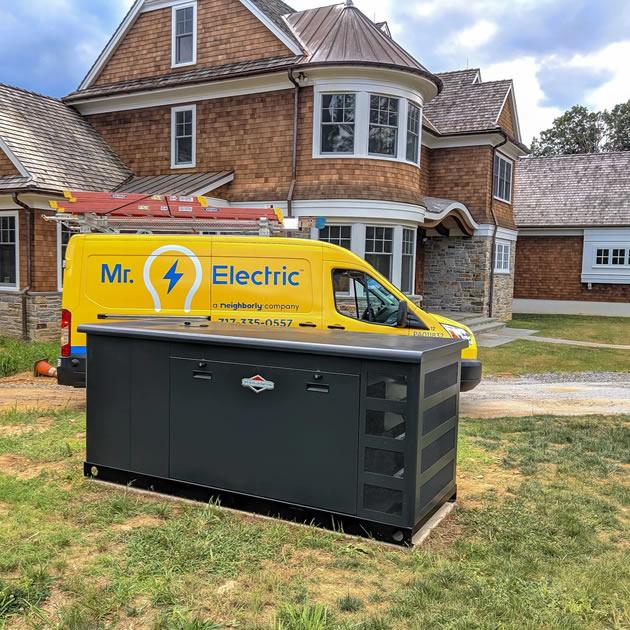Call this Tuesday to Get $35 OFF.
Hire Local Trusted Electricians Now
Call This Tuesday to Get$35 OFFCall this Tuesday to Get $35 OFF.
Hire Local Trusted Electricians Now
Call This Tuesday to Get$35 OFFInsurance companies get a bad rap – and to be fair, it’s not hard to see why. You pay your premiums on time every month, year after year, and then the one time you file a claim, the process feels like climbing a mountain in flip-flops. Maybe they ask for more documentation, delay the payout, or deny the claim altogether. Frustrating.

But here’s something to think about: A lot of that tension between homeowners and insurance providers comes down to one thing… risk management. Insurance companies exist to protect against risk, but they also expect homeowners to take reasonable steps to reduce that risk on their own.
And when it comes to electrical systems, the details matter more than most people think. This is especially true when the matters is something as consequential as a standby generator installation.
Everything in your home, from the lights and kitchen appliances to your HVAC system, depends on electricity for power. When electrical problems arise,…
Read MoreA circuit breaker protects you and your family from electrical hazards. When it begins to malfunction, the risks can quickly snowball from a…
Read MoreCeiling fans add style and improve energy efficiency, but the process of installing or replacing a ceiling fan isn't always as simple as…
Read MoreYour home's electrical system is something you rely on every day, but it doesn’t always make it obvious when there’s a problem. Flickering…
Read MoreYour home’s electrical system is one of its most important yet one of the most potentially dangerous components. Outdated wiring, overloaded circuits, or unpermitted work can create grave fire hazards – and insurance companies know this better than anyone.
That’s why many insurance policies include fine print about maintaining your electrical system in “safe and functional condition.” Translation? If your insurer finds that a preventable electrical issue caused the damage, then they might deny your claim.
Regular inspections, timely electrical repair, and hiring a licensed electrician for upgrades or installations all prove to the insurer that you’re being proactive, not negligent. Just remember to keep everything documented and backed up!
A generator installation is a big deal for any home. Done correctly, it keeps lights, heat, refrigeration, and security systems running when the grid goes down. Done poorly, it’s a ticking time bomb.
For instance, incorrectly-installed generators can “backfeed” electricity into the main power lines. This endangers utility workers and can destroy sensitive appliances. Moreover, faulty wiring or undersized cables can overheat and cause fires.
These are exactly the kinds of issues that insurance companies fear most. So if you ever have to file a claim after an electrical fire or power surge, one of the first questions your insurance adjuster will ask might be: “Who installed the generator?”.
Answers like “My buddy helped me” or “I watched a YouTube tutorial” could raise red flags.
When it comes to insurance, documentation is everything. Keep records of any electrical repair or installation work you’ve had done. This is especially important for major upgrades like generators, circuit panel replacements, or rewiring.
This isn’t just for when things go wrong. Proper documentation helps your insurer assess your home’s risk level, and it can actually work in your favor. Homes with modern electrical systems and professionally-installed generators are considered lower risk, and this can mean lower premiums.
Additionally, most residential areas require electrical permits for permanent generator setups. Having a signed inspection report from your local authority keeps you compliant with code and shows your insurance company that everything was done by the book.
If you’re considering a professional generator installation, then treat it like the major home upgrade it is. Here’s a quick checklist to protect both your property and your insurance coverage:
If you’re looking for local uniformed professionals, then consider Mr. Electric. When you work with a certified electrician at Mr. Electric, you’ll have a partner with your interests in mind. In fact, we back our workmanship with a 1-year guarantee so you can rest assured.
Call or message Mr. Electric at any time of the day – or night – to speak with a member of our team. We’re happy to schedule an appointment or arrange urgent assistance.
Smart doorbells have moved from high-tech novelty to an everyday essential. They help you monitor deliveries, deter porch pirates, and keep an eye…
Read MoreElectric vehicles have taken the world by storm, and public charging stations are popping up across the nation – but nothing beats an…
Read MoreFor many business owners, few words spark more anxiety than “rewiring.” It sounds expensive, messy, and disruptive. And while it’s true that upgrading…
Read MoreWe’re all familiar with the electrical panel, but knowing how to flip a circuit breaker doesn’t cut it for responsible homeowners – especially…
Read More